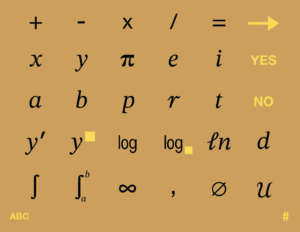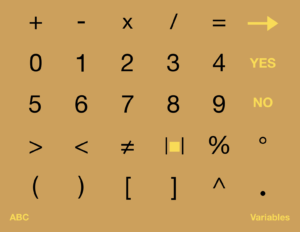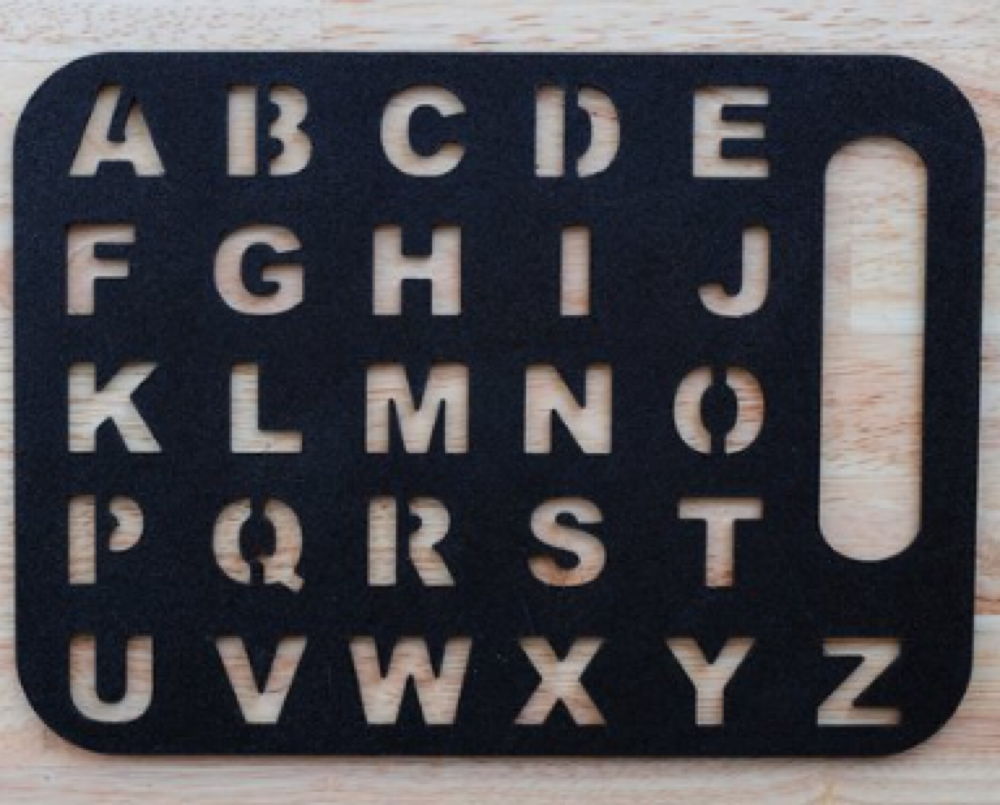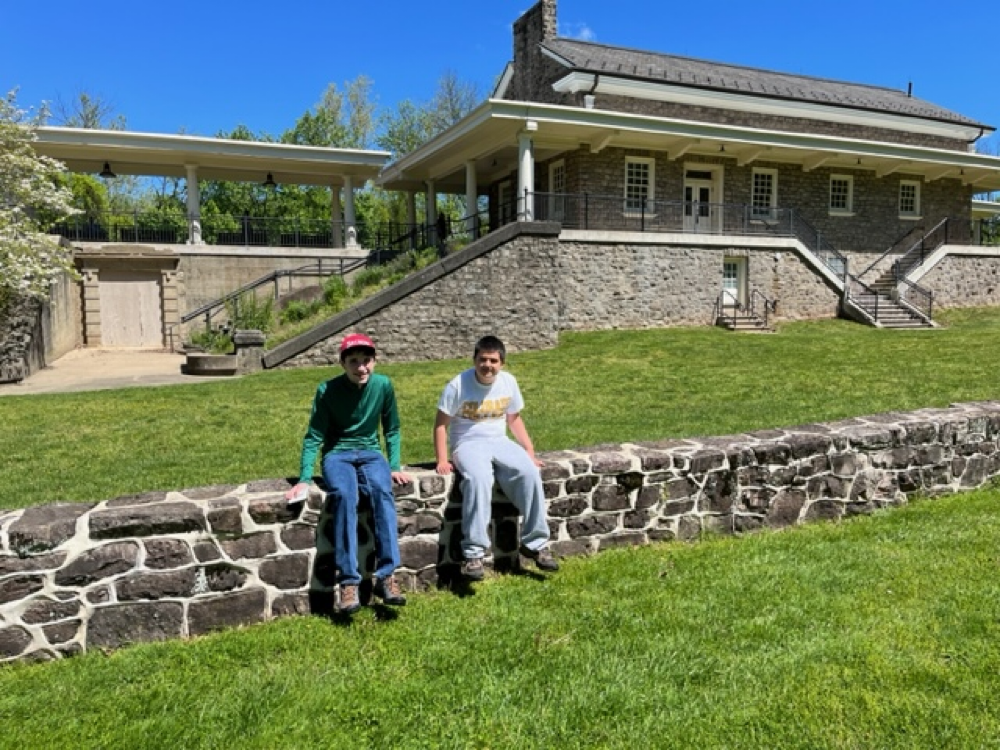Academic spellers have no letterboard for statistics, so I created one! Maybe you will find it useful too! You might also like my math board. Anyone else bored with the regular board? After you give it a try, let me know! Whoever says I’m enjoying math is right! Enjoy the letterboard as a pdf download to print and laminate (10 mil works great!).
My Third Speech: Training on How to Communicate with Nonspeakers
Here is the third speech I’ve delivered for my Intro to Communications class at NCC.
Transcript of My Speech
Have you had to fight for your right to…communicate? The Beastie Boys railed about partying but I’m going to advocate for communicating. Specifically, I’m going to make the case that nonspeakers need better communication partners, and to be better communication partners, teachers working with nonspeakers need better training. Getting teachers to acknowledge that talking isn’t the only way to share information or show intelligence, and to be patient in exchanges with nonspeakers, and to know how to help with spelling and typing, would be epic. So let’s do it!
It’s important to realize that communication is a challenge for many on the autism spectrum. According to Healthline Media, around 25 to 30 percent of children with autism are minimally verbal, meaning they speak fewer than 30 words, are unreliable speakers, meaning they often don’t say what they mean, or they don’t speak at all. A recent study looking at three national datasets of autistic elementary school students found that speech and language therapy was the most common therapy they receive, and 85% do. The University Center for Excellence in Developmental Disabilities estimates that one-tenth of all students in special education classrooms use an Augmentative and Alternative Communication (or AAC) device.
Not only do these things cost a lot of money, they also add lots and lots and lots of stress onto school, which is stressful enough! My school district spends roughly 1.7 million dollars on speech and language services every year. That’s in addition to approximately 6 million dollars on autism support. Some serious spending!! Actually it is really incredible. Let’s just make sure it’s spent as effectively as possible. And right now it isn’t, at least not the portion spent on nonspeakers.
A blistering critique of AACs, specifically computerized ones, from 1996 had it right, that these devices add “complexity into an already complex situation: the education of a student with disabilities.” I can share from experience that they are so complicated to use but don’t let you actually communicate. Don’t we think communication is the whole point? I do! So let’s focus on the natural victories and play to nonspeakers’ strengths. That means the right communication tools and surrounding nonspeakers with well-trained communication partners.
The tools are easy; the training is hard. The only tools I’ve found helpful are a pencil and paper, a laminate, and a keyboard. But they work best if I’m working with a really good communication partner. This is huge! I can’t stress it enough how essential this is. Nonspeakers can only be heard if they’re communicating with someone who knows how to listen. And listening to a nonspeaker I’d say takes some getting used to. The good news is that we know just how it’s done.
According to Jennifer Kent-Walsh and David Mcnaughton, the list of skills and strategies include the “(a) use of extended conversational pause time or expectant delay…(b) being responsive to communicative attempts; and the c) use of open-ended questions.” These were published in 2005, the same year my sister was born. She’s now in college so why aren’t these better known by now?
The problem is the lack of appreciation for the communication partner role and even more the lack of training for it. The intermediate unit in my area, for example, offers two workshops on teaching students with autism. Neither one even mentions nonspeakers or how to be a good communication partner. How is that even possible? Missed opportunities mean serious consequences for nonspeakers, and that’s unacceptable!
So let’s change this!! To start, let’s spread the word about the C4A Academy Elizabeth Bonker created. The site includes information about teaching nonspeakers to type and, best of all, how to be a good communication partner. More information is available at the website on my slide. Be part of the presuming competence, nonspeakers-are-awesome revolution!! Thank you!!
My Second Speech: The Amazing Spelling Method
Here is the second speech I’ve delivered for my Intro to Communications class at NCC.
Transcript of My Speech
Today I’m going to share something life-changing with you. It’s been life changing for me, how it’s given me a voice and confidence and the best friends ever. And it’s going to be life changing for you. Rights that I think are vital to society are not reaching millions of people. Rights that I think are essential to our humanity are not reaching millions of people. But we’re going to change that!
I want you to imagine for a moment that all of a sudden you can’t talk. Keep in mind that talking gets you what you need, it’s how you can show understanding and intelligence, and it’s entirely expected all of the time. Most other people judge you based on the things you say, but you can’t say anything. Now imagine engaging in a conversation for the first time by writing with someone’s help and people doubting the words are yours. Only an independent method is going to do it, but issues you have with motor control seem to make that impossible. Right when you are at your limit you discover a miracle: communication through spelling.
Are you hooked? I’m anticipating I’ll keep you hooked as I tell you all about the spelling to communicate approach and ones like it. The genius lies in the fact that these methods all presume competence, which means that, unlike everyone else, they assume nonspeakers are smart and trying their best. Through coaching nonspeakers to point to letters on a stencil letterboard, then a laminated letterboard, then a keyboard, then a keyboard on a stand, these methods get spellers communicating independently. This process simultaneously helps nonspeakers myelinate new pathways in their brains, and get better at controlling their eyes and their bodies as they get more fluent as communicators. Absolutely brilliant!
But don’t just take my word for it. My friend, Vince, writes about how spelling unlocked his mind and more importantly his voice and personality. Gregory loves how it’s made it possible for him to be an author and filmmaker. And Aaron appreciates how it sees autistic nonspeakers not like puzzle pieces but like acorns, tough and full of potential.
You will be shocked to hear how much controversy and pushback these methods have generated. The American Speech-Language-Hearing Association, for example, issued a directive to speech-language pathologists saying that spelling to communicate “should not be used” and considers it to be a “discredited technique” that actually harms nonspeakers. Are you kidding me?!
Thankfully we now have a rigorous study debunking this awful position. “Eye-tracking reveals agency in assisted autistic communication” was published in the journal, Scientific Reports, in 2020. For this study, researchers used mounted cameras in order to track spellers’ eye movements when they pointed at letters. The authors found that spellers “actively generated their own text, fixating and pointing to letters that they selected themselves.” This was “a very different conclusion about [spellers’] ability to convey their own thoughts than has been suggested by previous research.” Two big takeaways from this are that “nonspeaking autistic people who communicate with assistance can indeed offer insight into their condition and lives” and that “the cognitive abilities of nonspeaking autistic people have been significantly underestimated.” Most speakers are catching on…finally!
And it’s a good thing! As the eye-tracking study authors point out, around one-third “of autistic children and adults have limited ability to communicate using speech” and “not having a way to communicate effectively using language is arguably the most significant aspect of their disability, severely limiting educational, social, and employment opportunities.” This makes spelling so important, especially because each and every one of us has the right to communicate. This right was first established by the United Nations in 1948. Article 19 of the Universal Declaration of Human Rights states that “Everyone has the right to freedom of opinion and expression; this right includes freedom to hold opinions without interference and to seek, receive and impart information and ideas through any media and regardless of frontiers.” According to Sharynne McLeod in her 2018 overview of communication rights for the International Journal of Speech-Language Pathology, the “importance of communication rights is obvious, since they are included in almost every convention, declaration and covenant of the United Nations with few exceptions.” In 2014, the Universal Declaration of Communication Rights officially recognized “that the ability to communicate is a basic human right” and “that everyone has the potential to communicate” with “access to the support they need.” If you combine that with Article 21 of 2006’s Convention on the Rights of Persons with Disabilities, which argues that someone with a communication disorder has the right to “seek, receive and impart information and ideas on an equal basis with others and through all forms of communication of their choice,” I have the clear right to spell!
I know that our time is running out, so let me get right to the things you need to remember. First, everyone has the right to communicate. Second, everyone gets to decide what way of communicating works best for them. And third, spelling to communicate and methods like it are proven ways to give nonspeakers like me a way to be heard. Thank you so much for listening to the powerful voice I have now!
My First College Speech
Here is my first college speech, an assignment to introduce myself.
My Take on Conversations
I just started Intro to Communications at Northampton Community College. This is my first assignment!
About a month ago, I went to a Christmas party at my friend Vince’s house. What a great time! So many people gathered around the kitchen table and, as you can imagine, there were a lot of conversations going on. The real fun for me in those situations is to listen and respond to the mood they set. This time, everyone was happy which made me happy. It may not be talking, but I would consider that interpersonal communication. Roles like sender and receiver are involved, there are verbal and nonverbal messages, each time receivers respond with feedback, and it cycles around again. Quite a treat for a nonspeaker!
Zillions of conversations go on every day but not many meaningfully engage nonspeakers. How we communicate is really a big reason why. Spelling my individual words takes time and speakers don’t like to wait. I realize they rarely have to. Our brains can encode and decode almost instantaneously, and talking gets the messages out right away. Talkers frequently even think out loud which speeds things up even more. When nonspeakers try to participate, they typically can only take one turn and end up sharing something that the group moved on from long ago. An understandable but demoralizing outcome!
Really, this illustrates the transactional model of communication perfectly. Issues for nonspeakers stem from the fact that conversations aren’t just interactions where you’ve got time to take your turn. They are a lot like taking nine turns all at once, while someone else does, too, so the right answer is always changing. That dynamic nature of communication is what can leave so many people out. Getting left out has many consequences for nonspeakers since conversations are what we use to share our identities and figure out what groups we’re a part of. Getting at this is why I’m taking this class!
Download Your Own Math Letterboard!
The standard letterboard teaches you how to write. Yet it isn’t sufficient for mathematics. With my math skills, I tried to solve routine calculus problems. Unfortunately, I wasn’t able to use a regular letterboard. Now I needed to design my own. You’re looking at the result.
You can download the letterboard here. Please let me know if you’re more satisfied with this one.
My Origin Story
 At a young age I knew I was different. My body didn’t move the way I wanted it to. At age 2, my body changed. After some time, I felt lost in space. About age 5 I figured out how to write. Soon after I was able to show my teacher that I could communicate. We were working on a writing assignment about learning to play piano. All of a sudden I began to write words on her paper. She saw I made sense and encouraged me to keep doing it. I continued with this way of communication until this summer. My writing was difficult for others to understand.
At a young age I knew I was different. My body didn’t move the way I wanted it to. At age 2, my body changed. After some time, I felt lost in space. About age 5 I figured out how to write. Soon after I was able to show my teacher that I could communicate. We were working on a writing assignment about learning to play piano. All of a sudden I began to write words on her paper. She saw I made sense and encouraged me to keep doing it. I continued with this way of communication until this summer. My writing was difficult for others to understand.
A friend I met from Philadelphia is a speller. He told me about spelling. So my mom made an appointment with a practitioner that was closest to us.
The first time I went to a session I was very excited. The ride was only an hour and a half but seemed like an eternity. My first time on the letterboards was magical. I knew that I was born to spell.
It has been six months and my life has begun to change. I can’t believe how spelling has been embraced by my school. I am now able to type on a keyboard. I am also part of an amazing group of speller friends. Let me end with some encouragement for future and current spellers: keep going – don’t give up. The journey may be hard but it is so worth it.
I’m a Speller!
- Smart guy who loves hiking
- Intern for Nurture Nature Center
- Letterboard learner
- Advocate for non-speakers
- Journalist
- Music aficionado
- Someone, mom, who mostly makes you proud
- I’m also thinking neuroscientist
I wrote this list at the end of the school year when I was mostly just thinking of myself as a guy who hated school. I didn’t really hate school, I hated how I made more mistakes than I wanted to and lost my confidence. Not how I imagined the year going!
My therapist, the awesome Miss Virginia, challenged me to set the record straight in my head. “Who are you really?” she asked me. I’m an amazing person!
And I’m getting all this against the odds. I’ve long hated using autism as a label to define myself. I’m a really smart guy who is sensitive to others’ emotions and that isn’t what people think of when they think of autism. But there are so many autistic people like me that it’s time to change the definition. And that’s especially true for non-speakers, who are always underestimated.

Now for my big news: I’m a speller! Through my friend, Matthew, I’m making more progress communicating with people beyond my immediate family than I ever have before! I’m participating in the life-changing Spelling 2 Communicate (S2C) movement. I’m working with the exceptional Miss Mimi to master the letterboard and making big progress, which is the best! My favorite part of this method is how it presumes competence and won’t stop presuming competence even if I make mistakes. I’m a major proponent of all non-speakers trying this!
Loud Advocates
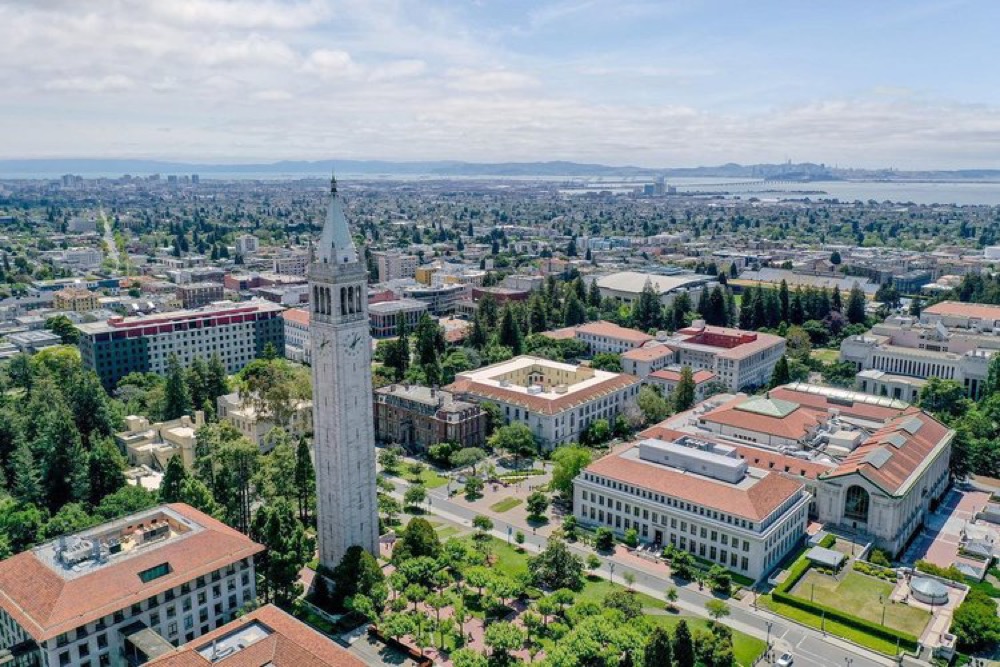
UC Berkeley campus
Many good stories involve heroes who are very strong or all dynamic in front of a crowd or athletic or amazingly handsome. This story involves two heroes who are incredibly brave. What makes them brave is their willingness to use their smarts and go into overwhelming situations to share those smarts with the mainstream.
I’m talking about David Teplitz and Hari Srinivasan, two non-speaking autistic people who just graduated with honors from the University of California, Berkeley, charting a new course for Cal and now going further in their efforts to prove to the world what non-speaking autistic people can do. Thanks to them, I’ve got hope that there’s greatness in store for me.
Hari and David show that there are big misunderstandings about non-speaking autism. In the 1980s, doctors largely thought that not being able to talk meant their patients were intellectually disabled.
In fact, according to Ronit Molko in a Learn Behavioral blog post from March 10, 2022, roughly 70% of non-speaking autistics were considered mentally retarded at that time. But doctors now know better and only 30% of non-speaking autistics get the intellectual disability diagnosis. Rather than a lack of comprehension, limited speech stems from apraxia, or a breakdown between the brain and the mouth that makes it impossible to get words out. Language isn’t the challenge.
The major hurdle is finding a way to “talk.” Hari and David have both learned to type. They use NaturalReader on their laptops to say what they type. I rely on writing by hand but am working on typing, too. Both are slow but way better than nothing! And Hari makes a good point: autistic brains move pretty fast, so they can take in information really fast.
This helps balance things out and makes it possible to “manage academics time-wise,” Hari points out on his blog, Uniquely Hari. It’s conversations that are tricky because they require such fast outputs.
But conversations and the understanding shown by others can change. What if someone could be more patient and wait for a response? Or if all people were willing to go back to a topic once a non-speaker was ready to share? That’s how Hari and David pushed their classmates at Cal.
Hari even helped co-teach a class, mostly preparing material in advance but needing students to be flexible with real-time questions. Important words are worth waiting for so you shouldn’t discount thoughts that are conveyed slowly. That’s what Cal wants its students to know and what Hari and David demonstrate.
They’re also doing something majorly awesome for me by demonstrating the mother load of the year. They’ve shown me that I’m not alone. There are other people just like me who can’t talk but master language, who don’t speak but are loud advocates, who, against all odds, reach incredible heights. My journey starts now!
Key Links
- Pay attention to how Hari talks: https://www.universityofcalifornia.edu/news/minimally-speaking-autistic-student-wins-soros-fellowship-phd
- Hari in his own words: https://uniquelyhari.blogspot.com/
- https://www.linkedin.com/in/harisri108/
- Hari in action: https://www.kalw.org/show/crosscurrents/2019–06–11/experts-called-hari-low-functioning-for-years-then-he-found-his-voice
- Hari and David: https://abc7news.com/uc-berkeley-cal-graduation-nonspeaking-autism-graduates-david-teplitz/11870714/
- The truth about non speakers: https://learnbehavioral.com/blog/myth-nonverbal-or-nonspeaking-people-with-autism-are-intellectually-disabled
Hiking the Appalachian Trail
Sometimes mom has my back, and that was definitely true starting in March 2020. Many times since then mom and I spent hours hiking, getting closer to my goal of hiking the whole Appalachian Trail. Mom mapped out hikes for us and dad would drop us off and pick us up. We kept at it after going halfway through Pennsylvania, then all the way through Pennsylvania, then through New Jersey, then New York, then Maryland and West Virginia! All told, we hiked 500 miles in 2020, from the NY/CT border to Skyline Drive in Shenandoah National Park.
We kept going in 2021. I’m nearly done with Connecticut now and will be over halfway through Virginia and into Massachusetts by the end of the summer.
How many people do that?!

Map of my hikes so far
Ages ago I would never have thought I could do something like that. I’m not really athletic and hate most sports. It’s taken me a long time to learn soccer and I even used to go to physical therapy all the time. You would think a long time ago that this would have been majorly too hard for me. But it wasn’t. I’m even strong enough to go over 20 miles in a day. (My longest hike was 20.2 miles.)
More than anything selling in a store, the Appalachian Trail is the best present there is. I’m a huge fan of the way it lets you be surrounded by nature whether you’re in a crowded area or not. And thanks to thousands of volunteers, it’s all marked with white blazes so that I can lead the way without worrying about a map. Best of all are the mile markers and signs helping you celebrate your progress!
I love hiking for many reasons! It makes me calm to do that for hours, and mom is with me, which is amazing. I’m so proud of how long I can hike and how good I’ve gotten at doing it. All of my confidence comes from being so good at it. I’m planning to hike as much as I can this summer!
Many times mom made mistakes. We hiked north one time that we meant to go south. We sometimes had more miles to our destination than we thought. We got surprised by big climbs. And we were not ready for crazy water crossings. Sometimes we got freaked out by animals, like snakes or a bear someone saw nearby.

The water crossing near Rausch Gap (Pennsylvania)
But no time was ever bad. And the mistakes were even part of the fun! Sometimes they were even the best part. And I’m more forgiving when we’re hiking because it’s my favorite thing. I’m all convinced that this has helped me be more forgiving off the trail, too. Another great thing to thank the Appalachian Trail for!
More than anything else, I love how much time it lets me spend with mom. We’ll be hiking for 8 or 10 hours a day just the two of us. We mostly are quiet but sometimes sing or talk. She always points out animals and mud and cool views, which she loves, and always makes me stop to look. Mainly I don’t mind but I’d often prefer to keep going.

Bear Mountain (New York)
My trail name is Calypso. I picked that because it was the name of my elementary school and Jacques Cousteau’s research boat. I love oceanography and exploring and I love my school and Mrs. G, so it seemed like the perfect choice.
Hope to see you on the trail!



